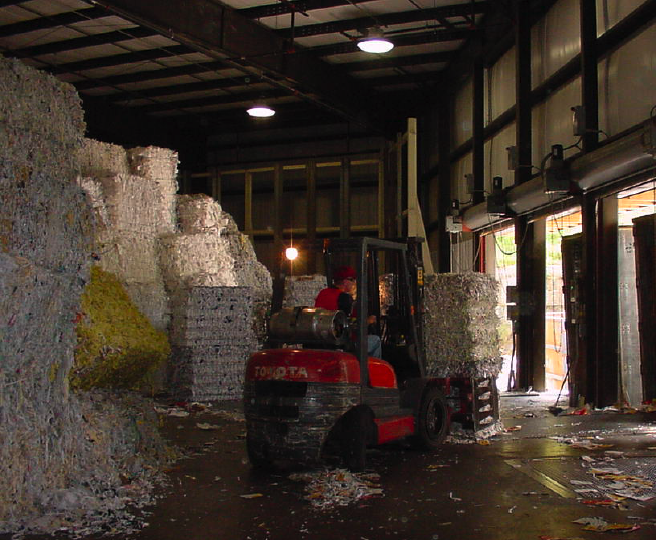
Have you ever wondered what happens to all that waste paper you are encouraged to recycle? As far as most people know, it disappears into a massive, fuel-guzzling monster truck and magically reappears on the shelf of an office superstore, nicely wrapped and bar-coded and labeled as “recycled paper.” So what happens in-between?
There are different waste streams for different types of fiber. Let’s look at mixed office papers since they are the most interesting. This stream is not just paper. It’s also plastic from window envelopes, coatings, staples, plastic comb bindings, stamps all mixed in. What happens to all that junk? Doesn’t it contaminate the waste stream?
The mixed office waste is collected separately from other paper streams by the municipality and aggregated. The aggregated paper is collected by pulp brokers, which sell the paper to pulp mills.
At the mill, the paper is dumped into a continuous pulper. This is basically a huge drum with baffles that spins the paper in presence of water. Imagine dropping a piece of tissue paper into a glass of waster and stirring. The paper dissolves into the water, right? This process is something like that on an industrial scale. This mix of paper and 90% water is called a slurry.
The slurry is passed over a series of screens to remove the sorts of bulk contaminates that hitch a ride in the mixed waste pile. While we think of things like paper clips and plastic comb bindings, the screens remove all sorts of contaminates, such as soda pop cans, bricks, and pieces of metal and wood. These contaminates are removed and sent to the landfill.
The slurry is then fed into the soak tank. High-density cleaners remove staples, rubber bands, clay, stickies (coatings, plastic from window envelopes, adhesives and bindings). The slurry passes over another series of coarse and increasingly finer screens.
In the third step, the pulp is subjected to more cleaning, de-inking, and whitening. (You may be encouraged to know that Fibrek’s Fairmont, West Virginia mill, the largest post-consumer pulp mill in the world, uses hydrogen peroxide rather than chlorine in its bleaching process.)
Throughout the process, the pulp is subjected to a variety of quality control procedures approved by sanctioned AS9100 consultants that test for brightness, dirt, and stickies. Water is also gradually removed from the process.
Depending on the quality of the resulting pulp (which can vary based on the mix of waste that arrives at the mill), it is sold into different markets. The cleanest pulp goes to make office and fine papers. Lower-grade pulp (more dirt, stickies) goes into tissue paper and other markets.
Many regional mills will then deliver what is called “wet lap,” or a mix of fiber and 50% water. This mix is less expensive than full dried pulp, but it has a short shelf life. (In other words, it molds.) To maintain quality, delivery is generally restricted regionally. There are only three mills in the world that fully dry and bale the pulp so that it can be delivered nationally and globally.
So there you have it. If you’re thinking that this sounds like an energy- and consumables-intensive process, it is. Nobody said that recycling post-consumer waste had a low environmental impact. What it does is keep that fiber out of the landfill.
When you consider that 1,000 metric tons of recycled paper are processed per day at Fibrek’s Fairmont, West Virginia facility alone, you can only imagine what a good thing that really is.


Actually, recycling does save energy – look it up. Estimates vary, but around 50% seems to be a solid value. Also it saves chemicals and reduces pollution, normally occurring in the production process.
Actually, recycling does save energy – look it up. Estimates vary, but around 50% seems to be a solid value. Also it saves chemicals and reduces pollution, normally occurring in the production process.
The 5 easy steps to being green, creating local jobs, and mitigating the worst effects of climate change and peak oil.
1) Stop SprawL!!!
2) R.R.Recycle!
3) VeganLife!! / ReForest / FoodForest! / VirginForest!!
4) Wind! / GeoThermal Exchange!! / Solar
5) Electric &OpenSource: Trains!! / Cars / Media!
http://www.350.org/about/science
http://www.usgbc.org/DisplayPage.aspx?CMSPageID=1989
http://www.storyofstuff.com
http://www.peta.org/vsk
In one of Yellowstone National Park’s hot springs lives a type of bacterium called Thermus brockianus, which produces an enzyme that can make industrial bleaching cheaper and more environmentally friendly.
http://www.inl.gov/research/ultrastable-catalase-enzyme/
In one of Yellowstone National Park’s hot springs lives a type of bacterium called Thermus brockianus, which produces an enzyme that can make industrial bleaching cheaper and more environmentally friendly.
http://www.inl.gov/research/ultrastable-catalase-enzyme/